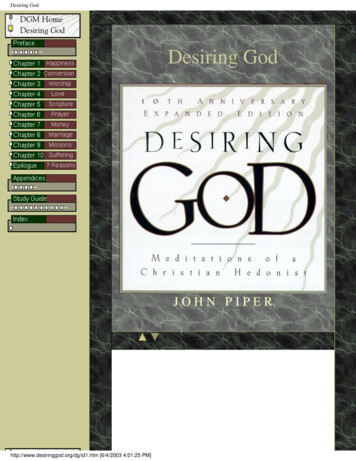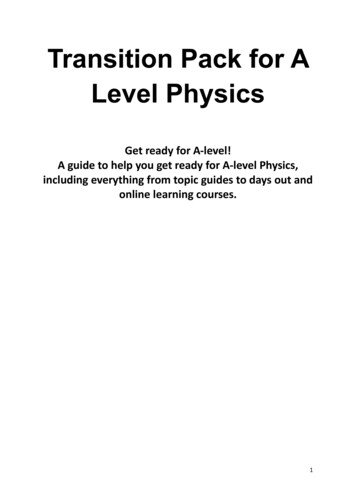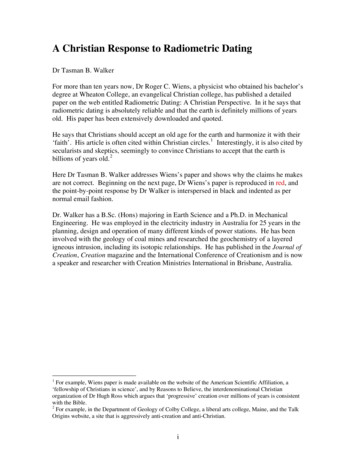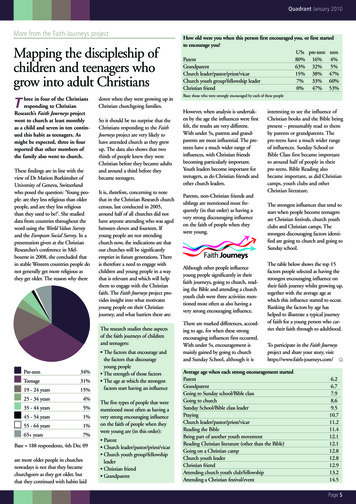
Transcription
A Christian Physicist Examines the Big BangTheoryby Steven Ball, Ph.D.September 2003
DedicationI dedicate this work to my physics professor, William Graziano, whofirst showed me that the universe is orderly and comprehensible, andstirred a passion in me to pursue the very limits of it.Cover picture of the Egg Nebula, taken by Hubble Space Telescope, courtesyNASA, copyright free1
IntroductionThis booklet is a follow-up to the similar previous booklet, A Christian Physicist Examines theAge of the Earth. In that booklet I discussed reasons for the controversy over this issue and howthese can be resolved. I also drew from a number of fields of science, ranging from the earth’sgeology to cosmology, to show that the scientific evidence clearly favors an age of 4.6 billionyears for the Earth and about 14 billion years for the universe. I know that the Big Bang Theoryof cosmology is not so readily accepted in some Christian groups, precisely because it points toan older universe. But I appealed to reason and the apparent agreement with the scriptures [1]when considering the evidence. However, in an attempt to preserve a continuity of discussion,that booklet only briefly covers some of the scientific evidence supporting the Big Bang theory,and the following discussion of scriptural references did not emphasize any relevance to the BigBang. There was much more to write on these, but it did not seem to fit well with the discussionon the age of the Earth. However, since I asked the reader to reason with me, it didn’t seemquite fair on my part to cut short the explanations. Thus I now offer a bit more for the readerinterested in this issue.Lately, there has been a widespread popular interest in finding out what modern science can tellus about origins, from the birth of our universe to the origin of life on planet Earth.Correspondingly, there are quite a number of popular books discussing the Big Bang theory ofcosmology and implications for religious faith, some claiming support for the Bible [2,3], othersby renowned scientists with varying personal philosophies of a non-Christian perspective [4,5,6].In one of the most well known of the latter, Nobel Laureate Stephen Hawking conjectures anunknown physics phenomenon, admittedly in an attempt to remove the need for a Creator [6].Indeed, it remains difficult to avoid the implications of the Big Bang theory, namely that therewas a beginning to this universe having a cause beyond the universe itself. I would like toaddress readers struggling to make sense of both the Big Bang theory and its relevance to biblicalfaith. Here you will find a summary of the evidence from the perspective of a Christian whosetraining is in the field of experimental high energy physics. As such, I fully expect the Christianfaith to stand up to the toughest questions I can ask of it, including how it relates to modernscience. If you ask tough questions too, I trust you’ll enjoy this account.If people tell me that you don’t need all of the science to be a good Christian with a strong faith,I fully agree. But science serves to enrich our lives and our faith. God has revealed truth to usthrough His Holy Word, the Bible, and through the physical laws and principles governing ouruniverse. I would not have chosen a vocation pursuing physics knowledge if I truly felt it hadnothing to offer of lasting value. I had a deep conviction that my physics training could serve agood purpose, as long as I was committed to following and serving God with all my heart. Infact, it is my hope and prayer that this booklet serves His purposes. Perhaps you can be a betterjudge of that than I can. It is my hope and prayer that the remarkable scientific account ourgeneration has been privileged to see and comprehend will stretch your mind and will enrichyour faith as it has mine.2
Chapter 1The Big Bang ControversyNot long ago, a popular bumper sticker had the following catchy phrase, “I believe in the BigBang Theory - God said it, and ‘Bang!’ it happened.” Although one may differ concerning theintent of this message, it seems clear that the original intent was not in support of the “The BigBang Theory” of cosmology, a commonly accepted theory among scientists concerning theorigin and development of the universe. The bumper sticker was merely expressing a widelyheld skepticism on the part of believers who hold that the Bible gives us the correct account ofhow it all began, regardless of what the scientific community believes. This skepticism towardsscience in general appears rather widespread in the Christian churches of America today.There is even a more common practice, which reveals a deep-seated distrust of science. It beganwith the Christian fish symbol, frequently seen on the back of cars owned by Christians. Thissymbol goes all the way back to first century Christians, who used it to identify themselves witha codeword, since the Greek letters in the word fish “ιχθυσ,” pronounced “ichthus,” also were thefirst letters of the words Jesus Christ, God’s Son, Savior. Outspoken supporters of Darwinianevolution recently began placing a symbol on their cars showing a bigger fish sprouting legs,outlined with the word “Darwin”, eating the smaller fish symbol. This certainly conveyed themeaning that Darwin’s theory is replacing the need for Christian beliefs. In response to this, yetanother bumper sticker shows a larger fish, outlined with the word “Truth”, eating a smaller“Darwin” fish. All of this punching and counter-punching is revealing the hostility betweenthose who hold to traditional Christian beliefs and those who believe that modern science hasrendered the Christian faith merely empty mythology.The ScripturesLet us momentarily put aside modern science and look at what the scriptures say about theorigins of the universe. The Bible explains that God was intimately involved in the entireprocess of creation. His purpose and plan are shown to be the driving forces behind theformation of this remarkable universe. However, many details concerning how are not given.The Bible is clearly not intended to be a science textbook. So how should one view the input ofmodern science? Do most Christians see modern science as contributing something ofimportance to their understanding of origins? No! The hostility revealed by the bumper stickersdoes accurately reflect a deep-seated skepticism of the scientific community and of science ingeneral. Consequently, most Christians accept a view of origins without any input from science,particularly since this is seen as sacred ground reserved for the Bible alone to address. Scientifictheories which appear to conflict with Biblical teachings are rejected.And tragically, those outside the Christian faith who recognize the value of science, but see theChristian community rejecting it, see no need to consider the claims of Christian beliefs.Ironically, more than ever before science is confirming the validity of the Bible. While many inthe Christian community feel no need for scientific confirmation of their beliefs, it is importantfor Christians to recognize that science is a strong ally of the faith. The testimony of the heavensis bearing witness to the design of a Creator as stated in Psalm 19:1, “The heavens are declaringthe glory of God; and their expanse is declaring the work of His hands”[1]. Scientists arerecognizing that the universe has a very remarkable design built into it. We shall discuss some3
of this design in the next chapter. But where does one look for answers to the questionsconcerning the ultimate cause and purpose behind it all? People who feel an aversion to religionstill have these questions. However, they cannot see themselves finding answers from a faiththat rejects science.My ChallengeI see no need for either group to compromise what they see as revealed truth, whether it is fromthe Bible or from science. Rather I wish to challenge both groups to consider how both form aremarkable consistency. Clear messages are being given to us both from the Bible and from thephysical universe, which speak of God’s careful design and His intent to communicate Hispresence to us. While it may always be possible to propose explanations for the scientific recordwhich deny any involvement of a Creator, it has become increasingly difficult to do this whilemaintaining intellectual honesty. The evidences for precise design built into the universe atevery level have become staggering. The same evidences supporting the Big Bang theory revealmany of these precision designs. Rather than recognizing the consistency between the scientificevidence and the Bible, some scientists have proposed bizarre explanations, such as theproposition that there must have been an infinite number of universes [7], and we happen to livein the one in which a long list of factors are fortuitously just right for our existence. But suchexplanations are not a very satisfactory response to the evidence. We have only one universe toobserve and draw our conclusions from. Rather than appeal to things that can never be verified,let us look to the evidence at hand. The evidence reveals a universe consistent with the accountof creation in the Bible, something that can be verified.When challenging Christians to examine the Big Bang theory, I fully realize that Darwinism isthe roadblock many face instead. Proponents of “Creation Science” claim that the Big Bangtheory is just another tool of evolutionary scientists to explain away the existence of the universewithout God [8]. Because it indicates vast ages for the universe and the earth, it is assumed bymany to provide ample time for random natural processes to give rise to the evolution of life.However scientists, even those working in the field of evolutionary biology, have successfullychallenged this assumption [9]. Establishing the Big Bang theory of cosmology does notvalidate Darwin’s theory of evolution, since the incredible complexity of life still defies ascientific understanding of its origin. Furthermore, attempts to rule out God as the originator ofthe incredible features of our universe do not find much support from the scientific evidence.We will see that the evidence actually points to a Creator of unfathomable wisdom, transcendentof the universe itself. And it is the growing strength of the evidence, not prevailing philosophicalwhims, that also explains the growing acceptance of the Big Bang theory. The Big Bang theorydoes not leave God out of the picture, since it is merely a scientific account of how our universehas dramatically changed since its infancy. The question of its ultimate cause strongly suggests aCreator with a definite purpose.What about Problems with the Big Bang Theory?Skepticism of the Big Bang theory’s validity based on scientific grounds is certainly welcome,since it is important to establish how much actual scientific evidence supports a given theory.Questionable data and biased interpretative frameworks are claims made by those choosing toreject theories now commonly accepted by the scientific community [8]. But scientiststhemselves, for reasons that will be discussed later, have been the strongest critics and have4
imposed a very thorough scrutiny of the Big Bang theory. Several valid questions have beenraised, some leading to a more careful formulation of the theory and a quest for more accurateastronomical measurements. Others highlight the fact that the theory is incomplete and does notyet explain all details of the history, composition, and structure of our universe. These have beenconveyed in popular accounts critical of the Big Bang theory [10], especially since provocativetitles tend to sell more books. But many of the criticisms and objections have since beenresolved with more accurate data and improved understanding, as we shall see. The Big Bangtheory has survived the intense scrutiny and in the process, even more compelling evidence hasbeen found in support of it.Our Response to the EvidenceAs we shall investigate in the next chapter, there is clear evidence that the universe is expandingfrom a hot, explosive beginning approximately 14 billion years ago. But before we explore this,let us ask ourselves “how should we respond to the evidence?” A healthy respect for the role ofscience does not require us to choose between it and the Bible. Rejecting the evidence fromscience may indicate a lack of faith that the God of the Bible could be the same One who wrotethe laws governing our universe. I encourage people to consider how God can use the samephysical principles, which are used to understand the Big Bang theory, to accomplish His willregarding creation. If the vast age of the universe is the only reason for rejecting the Big Bangtheory, then it’s time to give it thoughtful reconsideration.As I wrote in the booklet, A Christian Physicist Examines the Age of the Earth, the Bible doesnot permit a determination of the age of the earth or the universe from its passages withoutquestionable interpretations. However, creation itself does have much to tell us, containing arecord of its history all the way back to the moment of creation of the universe. We are now ableto examine the remarkable story written in the heavens more clearly than ever before. For thesake of the nonscientist reader, I will attempt to tell the story in the most basic terms possible. Itis helpful to summarize the development of our scientific understanding and the interestingaccounts behind our most important discoveries. Then we will then explore several of thepopular objections and corresponding answers. Finally we will consider how the Big Bangtheory relates to the origin accounts of the Bible, since the Bible’s authority is used to guide theChristian believer in a search for truth, especially in significant issues such as the creation of theuniverse.Why is the Evidence so Important?Before we begin, let us address why it is so important that empirical evidence is the primaryreason for the growing acceptance of the Big Bang theory. The evidence is far more valuablethan any interpretative framework or philosophical bias, since the evidence is no respecter ofpersons. It cannot always be forced to fit one’s favorite theory. Wrong interpretations willinevitably encounter inconsistencies that cannot be adequately explained as more evidencemounts or as the evidence is examined more carefully. But in order to allow science to worksuccessfully we must be willing to allow the evidence to guide us, to correct us, and to test ourideas. This is the basis for good science. In A Christian Physicist Examines the Age of the earth,I discussed criteria for good science, despite the fact that we cannot completely reproduce theevents of the Big Bang in our laboratories on earth. These criteria are important enough to repeathere. I wrote:5
The reliability of the evidence can be determined in a number of ways. First ofall, since our universe obeys certain laws and principles, the evidence should beexamined in light of these well-established laws and principles. Secondly, whenseveral independent sources are all giving very similar answers, it increases themeasure of confidence we have in the results. Good science requires both themeasures of self-consistency and consistency with other independent, yet equallyvalid methods. [11]While the Big Bang theory has not only survived intense scrutiny, a series of remarkableconfirmations have shown it to be one of the greatest scientific accomplishments of recent years,revealing an incredible story of how our universe developed into what we observe today. It hasbecome one of the strongest testimonies to the validity of the biblical account of creation, since itclearly confirms that our universe had a beginning, as described in Genesis 1, in which the causeof it is outside of the physical realm we observe. It is remarkable that the observations haveallowed us to trace the record of our universe back to this beginning point.But does our worldview permit us to examine this evidence thoughtfully? One holding a solidfaith in the Bible should have no fear of examining the testimony of the universe, since this toobears witness of God’s handiwork. And for the one who appreciates science, but is skeptical ofwhether it agrees with a Christian worldview, I also urge an open mind. You will find that theevidence provided by the universe doesn’t need a lot of speculative interpreting on our part.Leading scientists have simply provided a theoretical framework based on known laws andprinciples of physics to describe what we observe. The resulting Big Bang theory has providedus some very testable predictions, which agree well with the astronomical evidence collectedover the last four decades. Let us now consider the evidence supporting the Big Bang theory.6
Chapter 2The Evidence Continues to GrowWhen I was recently asked, “What is the greatest scientific discovery of the 20th century?” Ididn’t need any time at all to reflect. Without hesitation I replied that the discovery of theCosmic Microwave Background Radiation, made in 1965, showed us clearly that the universehad a beginning. One of the most fundamental questions of science was settled by one very clearobservation made by accident. Two Bell lab scientists, Robert Wilson and Arno Penzias, weretesting out a new microwave receiver, when they noted a low temperature background “noise”that persisted despite all efforts to remove possible causes, including the radioactivity in pigeondung! Not knowing any plausible reasons for the microwave radiation, they began callingscientists who might be able to help. When they relayed their findings to Jim Peebles, anastrophysicist at Princeton University, they finally received their stunning answer. It turned outto be the predicted radiation left over by the initial explosion that began the expansion of theuniverse itself. The Bell lab microwave receiver was the first telescope capable of analyzingsuch light waves, allowing an accidental discovery. This fascinating story is told in more detailby Robert Jastrow’s book God and the Astronomers [12].What was it about this discovery that convinced scientists that the universe had a very hot,explosive beginning? Did this simply fit a growing paradigm that had already gained a footholdin the scientific community? Hardly! As a mocking gesture, the name “Big Bang” had beengiven to the theory that predicted such a hot, explosive beginning by astrophysicist Fred Hoyle,who held firmly to his favored “Steady State” theory, in which the universe has no beginning. Infact, a number of scientists had earlier considered the Big Bang model to be philosophicallyundesirable, since it reveals a beginning which science itself cannot fully explain. Indeed, theBig Bang theory demands a cause from beyond the universe itself, since all matter, space, andeven time were created in one spectacular event. As Jastrow writes,At this moment it seems as though science will never be able to raise the curtainon the mystery of creation. For the scientist who has lived by his faith in thepower of reason, the story ends like a bad dream. He has scaled the mountains ofignorance; he is about to conquer the highest peak; as he pulls himself over thefinal rock, he is greeted by a band of theologians who have been sitting there forcenturies [12].No, the entire scientific community was not overwhelmingly eager to receive supportingevidence for such a theory. For it demands answers from outside the realm of science. But by1965, for most scientists the evidence was too glaringly obvious to ignore. It is noteworthy thatthe scientific community chose to accept what the evidence was clearly revealing, in spite ofpersonal bias against it. Perhaps we can all learn something important from this. But at the startof the 20th century, the view many scientists held concerning cosmology had no basis inscientific evidence. Let us briefly review how these changes came about.Einstein, Relativity, and his Personal BiasResistance to the Big Bang existed even before the theory was formulated. Efforts to avoid theconclusion of the Big Bang, that the universe had a beginning, were already in full swing when7
Einstein developed his theory of general relativity, back in 1916. Einstein had been busyworking out a new theory of gravity that would render Isaac Newton’s theory of universalgravity an incorrect description. This was quite an audacious move on Einstein’s part,considering the 250 years of stunning success of Newton’s universal gravity in describing orbitalmotion in our solar system. Astronomical events such as eclipses can be predicted accurately inadvance for hundreds of years or pinpointed backwards in ancient times. But Newton’s theory ofgravity was suspected to be inexact where gravity is very strong, such as very near to our Sun.Irregularities in the orbit of planet Mercury could not be explained by Newtonian gravity.Contrary to Newton’s view of time, Einstein had already shown with his theory of specialrelativity in 1905 that time could not be considered the same for all observers in the universe.There really isn’t any absolute universal clock, since measurements of time depend on anobserver’s reference frame. Comparing measurements made in one reference frame to thosemade in another frame moving rapidly relative to the first one reveals differences in the lengthsof objects and the times between ticks of a clock. This has been verified to high accuracy bymany experiments. Space and time are intertwined in such a way that we refer to both togetheras space-time. An excellent introduction to relativity limited to algebra can be found in reference[13]. But the theory of special relativity only considers reference frames moving at constantspeeds relative to each other, and therefore does not include gravity, where acceleration exists.However, Einstein believed that since Newton’s concept of universal time was incorrect, hisuniversal gravity must also be reformulated, since it incorporates the concept of universal time.After 10 more years of intense work, Einstein finally had a complete theory of relativity, one thatincluded acceleration and gravity, as equivalent concepts. As promised, general relativity onlyagreed with Newton’s universal gravity where gravity is weak, which holds true for the motionof most objects in our solar system. But where gravity is strong or in considering a vaster scaleof the universe, the theories prove radically different. General relativity connects the propertiesof space-time to its proximity to matter. High concentrations of mass warp space-time in such away as to effectively change the measurement of distances and time for observers at varyingproximity to it, even if they are not moving relative to one another. On the large-scale universe,the mass density of the universe determines the overall curvature or warping of space-time.Einstein, who had remarkable insight into the physical significance of his theory, began to applythe equations of general relativity to the universe itself, and soon found himself facing adilemma. He recognized that in solving the equations of general relativity, if nothing exists tocounteract the attractive force of gravity, then a static universe is not possible. In other words,gravity would serve to either pull the entire universe back together, or to slow it down if it wereexpanding. Einstein later admitted as “the greatest blunder” of his scientific career, his insertionof a term into the equations that had absolutely no observational basis, a term referred to as thecosmological constant. His reason is clear. The only way to get a static universe solution, inaccordance with his philosophical inclination, was to have something counteract gravity. Thecosmological constant would serve as this mechanism, even though there was no other reason toinvoke it. It represents a pressure derived from the energy of space-time itself. Popular sciencejournals have recently been making bold claims that Einstein has been vindicated; since it nowappears that the cosmological constant is actually non-zero [14]. However, this is somewhatmisleading, since Einstein’s intent was to show that the universe could be static, whicheventually proved to be incorrect.8
General Relativity: Predictions and ObservationsThe Russian scientist Alexander Friedman did not see any need for a cosmological constant, andchose to take Einstein’s more basic equations of general relativity and solve them for the entireuniverse. By assuming the universe is relatively uniform (homogeneous and isotropic) theequations can be solved, even without the aid of a computer. Although it now appears that theuniverse is not very uniform today (we see densely populated regions of galaxies interspersedbetween large voids), the assumption is still a reasonable one for two reasons. First of all, theconcentrations of mass we see today were not so unevenly clustered during much of the initialexpansion, as we shall discuss later. Secondly, the growing development of anisotropies in theuniverse does not significantly alter the overall solutions, which predict a uniformly expandinguniverse. His solutions were published in 1922 [15]. In contrast to Einstein’s static solution, allof his solutions involve a beginning point reached by extrapolating backwards in time. Althoughhis solutions were derived from the more basic equations of general relativity without thecosmological constant, this did not necessarily imply that they were a more correct description ofour universe. General relativity itself had not even been confirmed by experiment.In 1919, astrophysicist Arthur Eddington led a team of scientists to Africa to observe a solareclipse. Although solar eclipses had been observed many times before this, this occasion was toprovide a very important test of general relativity. Einstein realized that for a theory to besuccessful, it needed experimental verification. He had provided a bold prediction that easilyallowed his theory to be confirmed or be proven incorrect. The prediction was that starlightwould be bent by strong gravitational fields, such as light from a distant star passing near ourSun. Although the actual angle was very slight, the experimental measurement would revealwhether general relativity or Newtonian gravity was correct. Eddington’s team showedconvincingly that starlight is indeed bent by gravity, and that general relativity was the correctdescription of gravity. Additionally, the orbital irregularities of planet Mercury proved to be inexcellent agreement with the predictions of general relativity. In the following years, additionaltests would continue to confirm the accuracy of general relativity [16]. But while the theory ofgeneral relativity was vindicated, the question of whether the universe was static or expandingremained unanswered.Hubble discovers an Expanding UniverseThe Mount Wilson Observatory opened in 1920 with the largest telescope in the world, a huge100-inch diameter, reflecting mirror. This allowed sufficient resolution to begin identifyingindividual stars in galaxies beyond our own Milky Way galaxy. Using Cepheid Variable stars,whose brightness varies periodically, Edwin Hubble was able to measure the distances to thesegalaxies. These are considered standard “candles”, with established intrinsic brightness,allowing an observed brightness to be converted into a corresponding distance from us. Thedistances are immense, beyond what a spaceship traveling at near the speed of light could coverin a million years. Hubble also learned something about the universe. He was able to determinehow fast each galaxy moved relative to us, by measuring how much the wavelengths of lightwere changed according to the Doppler effect. Galaxies moving away from us have their lightstretched out to longer wavelengths, while those moving towards us have their light shrunk toshorter wavelengths. He found that the universe is expanding at an incredible rate. His famouslaw of cosmology was established by 1929, namely, that the further away a galaxy is from us, thefaster it is moving away from us [17]. Einstein, convinced of the results, decided his9
cosmological constant was the greatest blunder of his scientific career. The simple and elegantform of general relativity appeared to be sufficient to describe the universal expansion.Certain implications of this result were clear. The universal expansion is not like any ordinaryexplosion we can observe, where matter is thrust outward in all directions within measurablespace and time. This explosion involved the expansion not only of matter, but of space and timeas well. It makes no sense to ask what lies outside of the expanding universe, since it includesall of space-time, something we cannot visualize with our 3-dimensional perspective. We canonly use analogies to understand it. One very good analogy is the surface of a 3-dimensionalsphere. Since you only need 2 coordinates (latitude and longitude) to locate any point on itssurface, the surface can be thought of as a 2-dimensional realm. People confined to 2dimensions would not be able to visualize that their realm is a curved one, but they couldcertainly determine that by making some measurements over a large enough area of the surface.That is exactly why we needed to make measurements over very large distances to determine ifour realm of space is curved, and whether it will continue to expand or slow down and reverse atsome point. In either case, extrapolating backwards in time, the realm of the universe shrinks toa point, the beginning point where all space and time begins. A beginning then demands aBeginner, One who is not confined to the universe and the laws that govern it.The “Steady-State” UniverseBut acceptance of this obvious conclusion was not forthcoming. It would require much moreevidence to convince the scientists that the universe had a beginning. A
Correspondingly, there are quite a number of popular books discussing the Big Bang theory of cosmology and implications for religious faith, some claiming support for the Bible [2,3], others by renowned scientists with varying personal philosophies of a non-Christian perspective [4,5,6].










